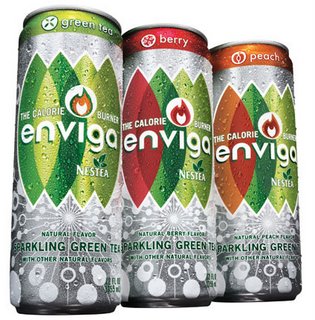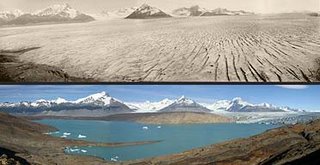
The Bottled Water Lie
By Michael Blanding, AlterNet. Posted October 26, 2006.
The corporations that sell bottled water are depleting natural resources, jacking up prices, and lying when they tell you their water is purer and tastes better than the stuff that comes out of the tap.
When Antonia Mahoney moved to Boston from her native Puerto Rico 35 years ago, the first thing she noticed was how much better the water tasted. Over the years, however, the water she was receiving from her tap began to lose its appeal. "Little by little, the taste changed," says the retired schoolteacher, who eventually gave up tap water altogether and began paying over $30 a month to get bottles of Poland Spring water delivered to her house.
Walking through Boston's Copley Square on a sunny day last month, however, she was intrigued by a banner advertising something called the "Tap Water Challenge." As she approached the table, a fresh-faced activist behind it told her the "challenge" was a blind taste test to see if passersby could tell the difference between bottled water and tap water. Mahoney turned her back while four water samples were poured into small paper cups -- two of tap water from Boston and a nearby suburb, and one each of Poland Spring and Aquafina.
"That's tap water," Mahoney declared after draining the first cup. "That tastes just like what I drink at home." Her confidence faded, however, as she downed the next three, which all seemed to taste the same. When the cups were turned over, it turned out that what she thought was tap water was actually Aquafina -- and what she thought was Poland Spring was actually the same Boston tap water she gets at home for free. "I couldn't believe it, I couldn't believe it," she says later. "You know I pay so much for that water. Now I am thinking to stop the Poland Spring."
Mahoney wasn't alone in that decision. A student from Connecticut who attends Massachusetts College of Art says that she has cartons of bottled water stocked in her dorm room, because she doesn't want to chance city tap water. After taking (and flunking) the test, she says now she'll start drinking from the faucet. "It tastes the same as the tap water I drink at home in Connecticut, and I drink that all the time," says the student, Katey vanBerkum. "Why spend your money on bottled water if you don't have to."
skip
In the past decade, the bottled water market has more than doubled in the United States, surpassing juice, milk, and beer to become the second most popular beverage after soft drinks. According to a 2003 Gallup poll, three in four Americans drink bottled water, and one in five drink only bottled water. Together, consumers spent some $10 billion on the product last year, consuming an average of 26 gallons of the stuff per person, according the Beverage Marketing Corporation. At the same time, companies spend some $70 million annually to advertise their products. Typical are Aquafina's ads advertising the beverage as "the purest of waters," Dasani's ads contending the water is "pure as water can get."
In fact, says Kellett, not only does tap water often taste the same as bottled water, but it is also often safer to drink as well. "They are spending tens of millions of dollars every year to undermine our confidence in tap water," she says, "even though water systems here in the United States are better regulated than bottled water." That's because tap water is regulated by the Environmental Protection Agency (EPA), which imposes strict limits on chemicals and bacteria, constant testing by government agencies, and mandatory notification to the public in the event of contamination.
Bottled water, on the other hand, is regulated by the Food and Drug Administration (FDA), which according to federal law is technically required to hold itself to the same standards as the EPA. The devil is in the details, however, since FDA regulations only apply to water that is bottled and transported between states, leaving out the two-thirds of water that is solely transported within states. State laws, meanwhile, are inconsistent, with some mirroring the FDA standards, some going beyond them and some falling far short of the national regulations. What's more, FDA regulations rely on companies to do their own testing, and perform voluntary recalls if products are found to be in violation of standards (if a company fails to do so, the Justice Department can order a seizure of products).
skip
In fact, many times bottled water is tap water. Contrary to the image of water flowing from pristine mountain springs, more than a quarter of bottled water actually comes from municipal water supplies. The industry is dominated by three companies, who together control more than half the market: Coca-Cola, which produces Dasani; Pepsi, which produces Aquafina; and Nestlé, which produces several "local" brands including Poland Spring, Arrowhead, Deer Park, Ozarka and Calistoga (a fact that itself often surprises participants in the Tap Water Challenges). Both Coke and Pepsi exclusively use tap water for their source, while Nestlé uses tap water in some brands.
Of course, Coke and Pepsi tout the elaborate additional steps they take that purify the water after it comes out of the tap, with both companies filtering it multiple times to remove particulates before subjecting it to additional techniques such as "reverse osmosis" and ozone treatment. Reverse osmosis, however, is hardly state of the art -- essentially consisting of the same treatment applied through commercially available home tap water filters, while ozonation can introduce additional problems such as the formation of the chemical bromate, a suspected carcinogen. In March 2004, Coca-Cola was forced to recall nearly 500,000 bottles of Dasani water in the United Kingdom due to bromate contamination that exceeded the U.K. and U.S. limit of 10 parts per billion. This past August, three grocery stores chains in upstate New York who all used local company Mayer Bros. to produce their store brands issued recalls after samples were found contaminated with more than double the bromate limit; in some cases, contaminated water was apparently sold for five weeks before the problem was detected.
Water originating with groundwater sources, meanwhile, can have its own problems. Citizens in states including Maine, Michigan, Texas, and Florida have all fought against Nestlé, whom they accuse of harming the environment by depleting aquifers and damaging stream systems with extractions of massive amounts of water though their local bottling affiliates, for which they pay next to nothing in fees and then sell at a huge markup. In 2003, Michigan Citizens for Water Conservation (MCWC) won a landmark court victory shutting down a Nestlé plant that was taking water from a stream that fed a wildlife refuge, sensitive marshland and several lakes.
"When you look at the fallen level of the stream, a couple of inches can mean everything to the environment," says Jim Olson, an attorney with the group. "It changed a natural regime that has built up over centuries, drying up ancient marshes of sedge grass relied on by wildfowl, interfering with spawning habits of great northern pike, and creating mudflats in areas where you used to be able to canoe." The injunction against Nestlé was partially overturned last year on appeal, however, in a decision that set a new, looser standard for water rights. The case is currently being considered by the Michigan state Supreme Court.
International Bottled Water Association spokesperson Stephen Kay defends the rights of bottled water producers to extract water, saying that bottled water producers are no different than any other industrial user or food producer that uses water in its products. Nationally, he says that bottled water only accounts for .02 percent of water use in the country, and that even in local cases, water producers are sometimes singled out unfairly as the most visible users of water, while other large users of water are given a pass. "We need to understand all of the uses on an aquifer and make sound and scientific judgements that take all of those uses into consideration," he says.
Kay questions the idea behind the Tap Water Challenges, saying that consumers have chosen bottled water not only for its consistency and taste, but also for its convenience. It isn't competing so much against tap water, he says, as it is against other beverage options. "If consumers are in a convenience store and they want a beverage without calories, caffeine, or sugar, it's just ready to go," he says. "In this era of obesity, it's irresponsible to try and sway consumers away from a healthful beverage choice."
While he allows that some tap water might taste as good as bottled water, he says, not all water users are so lucky. In some parts of the country, water is tinged with a sulphurous taste or suffers from a noticeable taint of chlorine. Indeed, at the Tap Water Challenge in Boston, one participant, Leila Saba, says she drinks tap water in Boston but chooses bottled water when she visits her parents at home in South Florida, where the water has an unpleasant taste. "I think tap water is always safe to drink," she says, "but they could make an effort to make the water taste better."
For the activists behind the taste test however, the growth of bottled water undermines the public's willingness to invest in the kind of infrastructure investments that could improve all public water supplies -- opening up the door in some cases to privatization of water systems by for-profit corporations. "People get in the habit of paying a lot more for their drinking water, and they say if we are paying for bottled water, there is no reason we shouldn't be paying a lot for these water services," says Tony Clarke, director of the Polaris Institute and author of "Inside the Bottle," a report critical of the bottled water industry. The downside, he says, is increased cost. "Whenever there is a public service utility taken over by a private service the first thing that happens is that rates are jacked up."
That's exactly what happened in the city of Cochabamba in Bolivia in 2000, when takeover of its water by the Bechtel Corp. sparked a popular uprising known as the Water War, in which citizens successfully reclaimed their water supply as a public right. Today, some 300 million people around the world still get their water from private suppliers. In the United States, water privatization has been a disaster, with cities such as Atlanta, Indianapolis and New Orleans seeing rates soar and quality suffer after contracting with private companies such as France's Suez and Veolia.
The struggle over control of water is only bound to get more heated over the next few years. Currently, more than 1 billion people lack access to safe drinking water, a number that is only bound to rise with increases in population and environmental stresses. This past March, environmental and indigenous groups converged on Mexico City to protest the World Water Forum, a meeting of industry and government leaders from around the world, sponsored by Coca-Cola., in which leaders failed even to agree that water was a basic human right. This month, citizens in 30 countries have planned demonstrations on the issue in an effort dubbed "Blue October," which will include a street celebration in La Paz to commemorate the Water War, and culminate next week in a three-day conference on water rights in Montevideo, Uruguay, from Oct. 28-31. In 2004, Uruguay became the first country to enshrine the right to safe water through a citizen-led constitutional amendment banning privitization and guaranteeing piped water and sanitation to all citizens. A similar effort kicks off this month in Mexico.
Activists like Kellett see a direct relationship between the commodification of water on the international level and the rise in bottled water among individual consumers. "Worldwide, people spent $100 billion on bottled water last year," says Kallett. "That's three times more than the amount that we'd need to spend to meet the United Nation's goals of giving everyone access to water by 2015." In the meantime, the activists with CAI will continue to bring their Tap Water Challenges on the road in an effort to convert people one by one. Purity, they contend, is only a twist of the faucet away.
CAI will hold a Tap Water Challenge at 1 p.m. today (Oct. 26) at Denver's Writer Square. Student groups will also hold Tap Water Challenges across the country next month on Nov. 14. For more information, visit Corporate Accountability International.
Michael Blanding is a freelance writer living in Boston. Read more of his writing at MichaelBlanding.com.
~~~~~~~~~~~~~~~~
People are being hoodwinked into giving huge amounts of money to an industry that takes advantage of our environment and brings in more profits than the pharmaceutical industry. ONE HUNDRED BILLION dollars could have done a lot to bring potable water to the over one billion people in this world now without it. What a scam. Water is NOT a commodity, it is a human right. Fresh water resources are dwindling in many parts of the world, and all companies like Coke and Pepsi can think about is profit at the expense of the poor in countries that are vulnerable to them, and in this country where they think they own our acquifers. It's time to boycott their bottled water.
My other writings on this:
Stand Up To Corporations That Kill
Globalization/Time To Take Action
Who Owns The Water?
 There's a way you can test your body fat percentage online. All you need is a cloth tape to measure different parts of your body.
There's a way you can test your body fat percentage online. All you need is a cloth tape to measure different parts of your body. 
 Alicia Silverstone, age 30, became a vegan recently. Her story is featured in next month's Shape magazine.
Alicia Silverstone, age 30, became a vegan recently. Her story is featured in next month's Shape magazine. 
 The
The  PastaQueen has one of the
PastaQueen has one of the  Greg Overholtzer made the decision to change his life and begin dieting and exercising about four years ago. At that time he weighed a dangerously obese 600 pounds. Today he is down to 242 pounds.
Greg Overholtzer made the decision to change his life and begin dieting and exercising about four years ago. At that time he weighed a dangerously obese 600 pounds. Today he is down to 242 pounds. 

 In Touch Weekly has Oprah on their cover this week and the caption reads "
In Touch Weekly has Oprah on their cover this week and the caption reads "

 Is Nicole Kidman wearing a girdle beneath this beautiful dress? Or is it the all new '
Is Nicole Kidman wearing a girdle beneath this beautiful dress? Or is it the all new ' And they attribute all this talk to
And they attribute all this talk to  celebrities (including Oprah, Jessica Alba and
celebrities (including Oprah, Jessica Alba and  Weight loss is not a typical topic for Wired magazine, but this month they have a cover feature story on The Thin Pill.
Weight loss is not a typical topic for Wired magazine, but this month they have a cover feature story on The Thin Pill. 


 P.S. To me it looks like the logo branding of this 'negative calorie' soda, with that little flame above the 'i', along with some of their marketing materials, looks and sounds a lot like their competition; the
P.S. To me it looks like the logo branding of this 'negative calorie' soda, with that little flame above the 'i', along with some of their marketing materials, looks and sounds a lot like their competition; the 




 Tara Reid has never been overweight. She says she weighs 110 now and has fluctuated about 10 pounds over this point at times. (Her height is 5'4".) But despite being very slim, Reid decided a couple of years ago that she would like a flatter stomach. She wanted her stomach to be taut, like a six-pack.
Tara Reid has never been overweight. She says she weighs 110 now and has fluctuated about 10 pounds over this point at times. (Her height is 5'4".) But despite being very slim, Reid decided a couple of years ago that she would like a flatter stomach. She wanted her stomach to be taut, like a six-pack.
 It's been a while since
It's been a while since 
 My baby recently started daycare three days a week. (I keep calling him 'baby' all the time even though he will be three years old in four months.)
My baby recently started daycare three days a week. (I keep calling him 'baby' all the time even though he will be three years old in four months.)